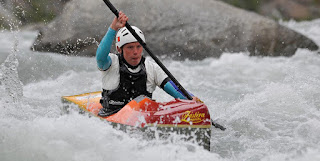The wildwater boat is sometimes viewed as a specialty boat, but in many ways it is more versatile than most of the boats on the market. Imagine you wanted to combine the speed of a surf ski, the buoyancy of a creek boat, the turning ability of a slalom boat, and the toughness of a whitewater boat. The wildwater kayak is what you would end up with.
According to the United States Canoe Association, wildwater kayaks have a maximum length of 4.5 meters (14 feet 9 3/16 inches). Rules prohibit wildwater kayaks from having rudders. Other than that, the design of kayaks used for wildwater is open. Most modern wildwater kayaks, however, are narrower than 20 inches at waterline and have considerable above-waterline reserve buoyancy. Much of the reserve buoyancy is in the “wings” that flare out just aft of the cockpit.
Two examples of high end composite wildwater kayaks from Zastera are below:
 |
| The Zastera Corvette |
 |
| The Zastera Aggressor |
Those just getting into the sport can start with just about any durable kayak (yes, you will mix it up with rocks) that is 14’9″ or shorter. The Perception Wavehopper (discontinued in the U.S. but available used) and the Pyranha Speeder are reasonably fast polyethylene kayaks well suited for wildwater racing on Class I, II, and III whitewater.
Wildwater Kayaks are fast due to their narrowness. Their narrowness makes them “twitchy.” Their twitchiness makes them a challenge. Never a dull moment in a wildwater boat. In the unlikely event you start experiencing those kinds of moments, time to get a narrower boat.
Wildwater Kayaking is part of the Penobscot River Nationals Regatta on Maine’s Penobscot River in July 2016. The event is open to wildwater racers of all experience levels, and paddlers are at least as friendly as they are competitive. Come and join the fun!
